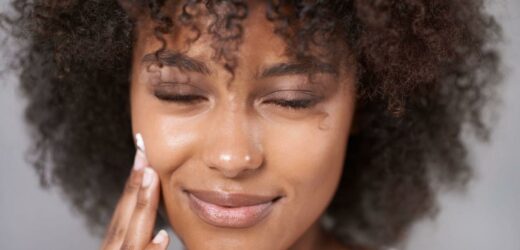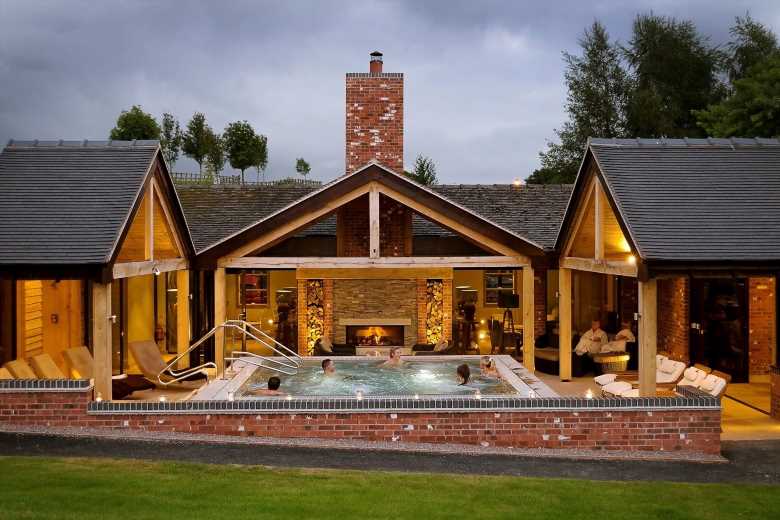It can be easy to overdo it with skincare acids. Here, a skin expert explains the difference between AHAs and BHAs and the best way to use them.
They might sound scary, but acids have skyrocketed to become one of the biggest buzzwords in the beauty industry over the last few years.
“Topical acids have become hero ingredients in medical-grade skincare because of their proven ability to resurface the skin,” explains Dr Bibi Maryam Ghalaie. “In essence, they act as chemical exfoliators, sloughing away dead skin cells to produce a brighter, smoother complexion. They can be extremely beneficial for treating acne, pigmentation, uneven skin tone and for improving fine lines and wrinkles.”
While they can be highly effective, it’s important to know which one works for you and your skin. Especially as there are so many. “The two most common types found in skincare products are alpha-hydroxy acids (AHAs) and beta-hydroxy acids (BHAs) which both work as exfoliants but in different ways,” explains Dr Ghalaie.
You may also like
Best face SPF: 14 beauty team-approved formulas to wear all year round
“AHAs, such as glycolic acid, are water-soluble, and this is convenient since our skin is composed largely of water molecules. They work by breaking down and eliminating dead skin cells on the outer layer of skin to expose brighter, fresher skin. AHAs also help promote collagen production.”
“BHAs, such as salicylic acid, are oil-soluble, which gives them the ability to penetrate deeper into pores to unclog them and help clear breakouts. BHAs are also anti-inflammatory and anti-bacterial, which is really beneficial for certain skin complaints like acne. It is so easy to implement these ingredients into your daily skincare routine, especially since many of the top skincare brands are incorporating these into their best products.”
Unfortunately, as acids are active ingredients that are highly effective, it can be easy to get excited by the results and overdo it. This will cause irritation and can also compromise the skin barrier. So how are they meant to be used? And how do you layer them? Here, Dr Ghalaie runs through everything you need to know.
You may also like
Lactic acid: everything you need to know about this gentle exfoliator
Which skin types are best suited to AHAs?
“AHAs are effective for skin that is suffering from dryness, flakiness or dullness. Once dead cells are removed by AHAs, like glycolic acid, any moisturising products applied on top can penetrate the skin more easily so they can actually help enhance the effects of your other skincare products.They are also very helpful for targeting signs of ageing, such as fine lines and early wrinkles.
“AHAs are well tolerated on most skin types but if you suffer from very sensitive skin you should seek the advice of your cosmetic doctor or dermatologist before using them.For more sensitive skin or for people new to AHAs, I suggest the use of lactic acid, which is a more gentle AHA that results in a milder exfoliation. Individuals with dark skin can occasionally react to AHAs with a paradoxical darkening of their skin, so in these cases, AHAs should be used with caution and on medical advice.”
Which skin types are best suited to BHAs?
“BHAs, including salicylic acid, penetrate much deeper into pores, loosening the dead skin cells and alleviating clogged bores.They can help break down pimples and blackheads. This makes them well-suited for oily skin and acne-prone skin.Salicylic acid also has anti-inflammatory properties so it can be very effective at calming inflamed and red skin and brightening the complexion.
“Individuals with an allergy to aspirin should avoid salicylic acid since they are in the same family of compounds. To ensure potency on your skin, I recommend using a topical salicylic acid of at least 2% strength.”
You may also like
Salicylic acid: what is it and does it help clear up blemishes?
Can you use an AHA or a BHA together?
“It is indeed safe to use AHAs and BHAs together. They target different actions (as discussed above) so they have different benefits. In essence, BHAs disrupt the connections between dead cells whilst AHAs cause dead cells to detach and slough away. In this way they can work really well together, synergistically.
“It could be argued that if you use a really effective BHA, then an AHA is not necessary since BHAs are more potent and penetrate deeper.It is really important to note that when using topical acids on the skin, an SPF of at least 30 afterwards is essential, even in winter and in cold weather.”
Which acids can you use together?
“This really depends on your age and your skin type and any particular skin complaints you may have. I recommend giving advice on combining acids based on age.
“AHAs and BHAs can certainly be combined. For example, for oily skin, a salicylic-based cleanser can be used followed by a glycolic acid toner. Generally, a glycolic acid is great for dry, dehydrated or combination skin, whereas salicylic acid would be perfect for oily/spot-prone/acne skin.
“L-ascorbic acid (also known as vitamin C), should not be applied immediately after using topical AHAs or BHAs as this can cause skin irritation and redness. So if you are using a vitamin C product, perhaps apply it later in the day or use these products on different days.
“For those under the age of 20, it is not recommended to use topical acids without being under the supervision of a doctor and unless prescribed by your GP or dermatologist.”
You may also like
Best vitamin C serums to brighten skin and treat hyperpigmentation
When layering acids, what factors should you consider to determine order of application?
“I recommend applying your AHA and BHA at different times of day. I suggest using your BHA in the morning and your AHA at night. Alternatively, they could be used on alternate nights.
“If you want to apply them at the same time, BHAs should be applied to oilier areas such as the T-zone and AHAs everywhere else to avoid doubling up on the application on any section of skin.The acids can of course be layered over each other, but this increases the risk of irritation and dryness.
“AHAs and BHAs are close in pH (both are between 3.0 and 4.0), so this is not a determining factor in application.However, if you are using them together, the golden rule for skincare applies, always apply the thinnest product first, and the thicker product on top.”
What happens to your skin if you irritate it?
“Topical acids should never be overused. As these productsare becoming more and more popular I have noticed that some patients are over-exfoliating; using too much and too frequently.The signs of overuse include irritation, burning, or peeling; redness and inflammation; or wax-like skin texture.
“You should always check the ingredients in the rest of your skincare routine, especially retinols and antioxidants like vitamin C, which should be avoided immediately after topical acids. It is always best to allow your skin to completely absorb one ingredient at a time to reduce the risk of over stimulation and any adverse reactions.”
You may also like
Best vitamin C serums to brighten skin and treat hyperpigmentation
The best acid toners and serums
L-ascorbic acid, aka vitamin C: Murad Vita-C Glycolic Brightening Serum
How to layer acids in your skincare routine: Murad Vita-C Glycolic Brightening Serum Formulated with both vitamin C and glycolic acid, this Murad serum was created for a brighter complexion. It tingles slightly upon application, but the serum sinks in quickly and, over time, it will slowly balance out uneven skin tone and any dark marks caused by discolouration.
Shop Murad Vita-C Glycolic Brightening Serum at LookFantastic, £82
BUY NOW
Lactic acid: REN Ready Steady Glow Toner
How to layer acids in your skincare routine: REN Ready Steady Glow Toner A swipe of this stuff can help revive skin almost instantly, restoring its visible brightness while getting rid of dead skin cells that cause dullness. The best part is it’s so gentle, so there’s zero irritation and you can pretty much use it every single day.
Shop REN Ready Steady Glow Toner at LookFantastic, £28
BUY NOW
Salicylic acid: Paula’s Choice Skin Perfecting 2% BHA Liquid Exfoliant
How to layer acids in your skincare routine: Paula’s Choice Skin Perfecting 2% BHA Liquid Exfoliant Great at balancing skin, the concentration of spot-reducing salicylic acid with soothing green tea decongests pores and minimises new breakouts overnight. It won’t strip skin of moisture; instead, it’ll leave you with a clearer-looking complexion by morning.
Shop Paula’s Choice Skin Perfecting 2% BHA Liquid Exfoliant at SpaceNK, from £11
BUY NOW
Glycolic acid: Beauty Pie Dr Glycolic Pore-Purifying Glow Toner
How to layer acids in your skincare routine: Beauty Pie Dr Glycolic Pore-Purifying Glow Toner This glycolic toner really helps to make skin look and feel smoother and looking healthier. It’s so quick to use: simply dispense some of the formula onto a reusable cotton pad and sweep it around cheeks, nose, forehead, chin and neck. That’s it!
Shop Beauty Pie Dr Glycolic Pore-Purifying Glow Toner, £40 for non-members or £15 for members
BUY NOW
Retinoic acid: Medik8 Crystal Retinal 6
How to layer acids in your skincare routine: Medik8 Crystal Retinal 6 Boasting the same skin benefits of retinol, this nighttime product contains retinal, a form of vitamin A that works 11 times faster than retinol. Medik8’s Crystal Retinal 6 contains retinaldehyde, which only needs one conversion step in the skin to become retinoic acid (the active form of vitamin A in the skin that increases cellular renewal), whereas retinol requires two.
Shop Medik8 Crystal Retinal 6 at LookFantastic, £66
BUY NOW
You may also like
Azelaic acid for acne or scarring: what is it, how does it work and what are the best products?
Main image: Getty
Source: Read Full Article


